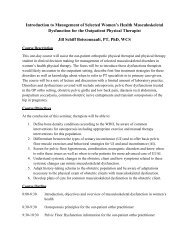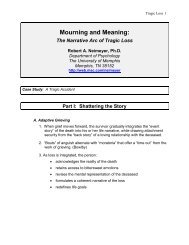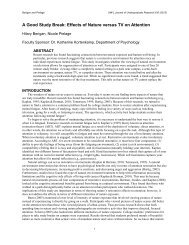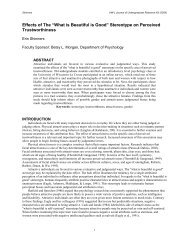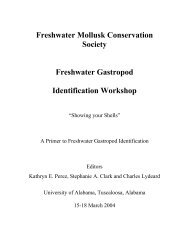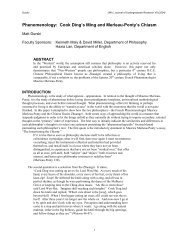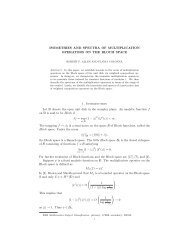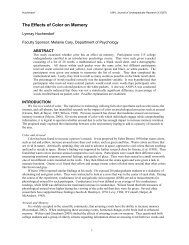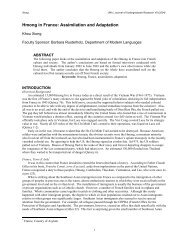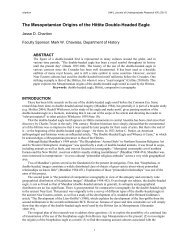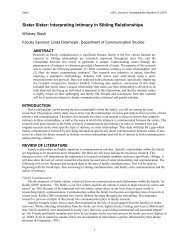A Guide for Terrestrial Gastropod Identification - University of ...
A Guide for Terrestrial Gastropod Identification - University of ...
A Guide for Terrestrial Gastropod Identification - University of ...
You also want an ePaper? Increase the reach of your titles
YUMPU automatically turns print PDFs into web optimized ePapers that Google loves.
Philomycidae<br />
Megan E. Paustian, <strong>University</strong> <strong>of</strong> Maryland<br />
There are 21 species (3 genera) that inhabit the eastern U.S. and Canada. All species <strong>of</strong><br />
Philomycidae (mantleslugs) are slugs. Pallifera are small slugs that are 7-30 mm long, while the<br />
medium-large Philomycus and Megapallifera are 50-100 mm long. The Philomycidae are<br />
characterised by a mantle that covers the entire dorsal body, and these slugs lack an internal shell<br />
and divisions on the foot sole. Philomycus alone employs a calcified dart in mating. Philomycid<br />
mantles are usually marked with longitudinal rows <strong>of</strong> gray, brown, or black spots, stripes, or<br />
chevrons, which <strong>for</strong>m patterns diagnostic to species. Some Pallifera species have solid color<br />
mantles.<br />
Philomycids occupy both deciduous and coniferous <strong>for</strong>est, although they favor old, moist<br />
deciduous <strong>for</strong>est (particularly beechwood and basswood). Some species prefer rocky cliffsides<br />
or upland pine <strong>for</strong>est. Some species have received special conservation status, particularly those<br />
that are restricted to small endemic ranges. Slugs are found in moist locations beneath loose<br />
bark, under dead logs, in tree crevices, and in leaf litter. They are best observed during rainy<br />
weather and at night when they move and <strong>for</strong>age on tree trunks (Philomycus, Megapallifera) or<br />
the ground (Pallifera). As implied by the family name, most species feed on fungus and lichen.<br />
Megapallifera consume algae that grow on tree trunks and other surfaces.<br />
This family is restricted to the eastern half <strong>of</strong> the U.S. and Canada. Species range north<br />
to Ontario and Nova Scotia, south to Florida and Louisiana, and as far west as Iowa and<br />
Oklahoma. Pallifera pilsbryi is found in Arizona.<br />
In<strong>for</strong>mation summarized from Pilsbry (1948), Burch (1962), Chichester & Getz (1973),<br />
Hubricht (1985), Fairbanks (1990).<br />
TAXON AUTHOR<br />
G-<br />
RANK DISTRIBUTION<br />
AL, AR, DE, GA, IA, IL, IN, KY, LA, MD, MO, MS, NC, NY, OH,<br />
Megapallifera mutabilis (Hubricht, 1951) G5 PA, SC, TN, TX, VA, WI, WV; Canada: ON<br />
Megapallifera ragsdalei (Webb, 1950) G3 AR, IL, KY, MO, OK<br />
Megapallifera wetherbyi (W.G. Binney, 1874) G2G3 KY, TN, VA<br />
IA, IL, IN, KY, MA, MD, ME, MI, NC, NY, OH, PA, VA, WI, WV;<br />
Pallifera dorsalis (A. Binney, 1842) G5 Canada: NS, ON<br />
AL, FL, GA, IL, IN, KY, MA, MD, MI, MO, MS, NC, OH, SC, TN,<br />
Pallifera fosteri F.C. Baker, 1939 G5 VA, WI, WV; Canada: ON<br />
Pallifera hemphilli (W.G. Binney, 1885) G4 IN, MI, NC, TN, VA<br />
Pallifera marmorea Pilsbry, 1948 G3 AR, IL, KY, LA, MO, OK<br />
Pallifera megaphallica Grimm, 1961 G5<br />
Pallifera ohioensis (Sterki, 1908) G5 ME, OH<br />
42



